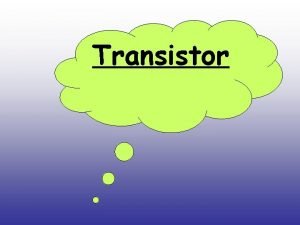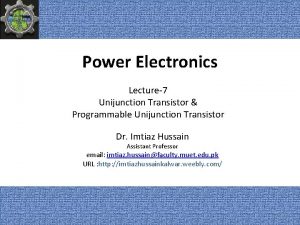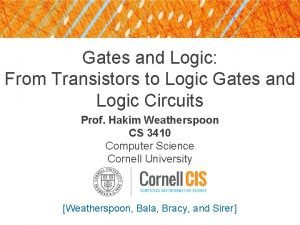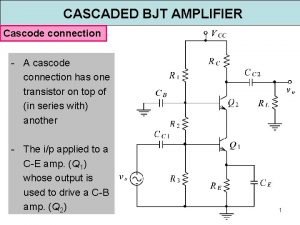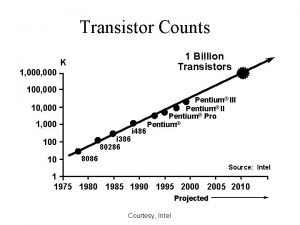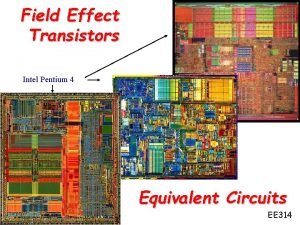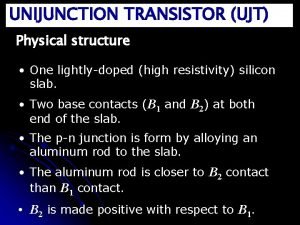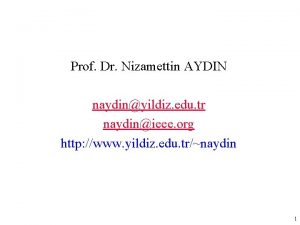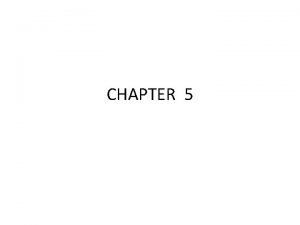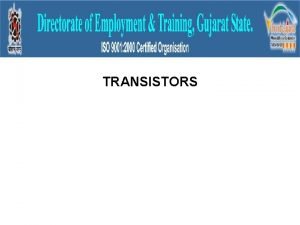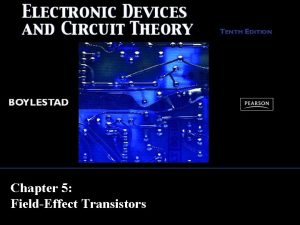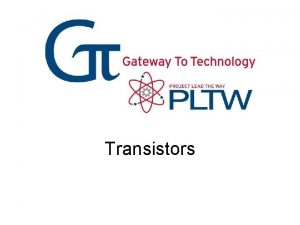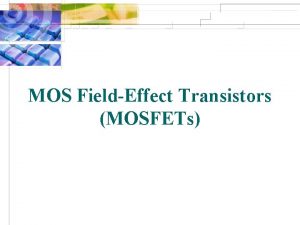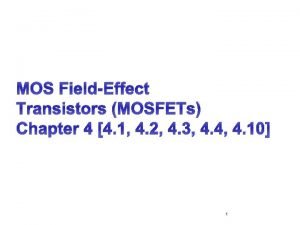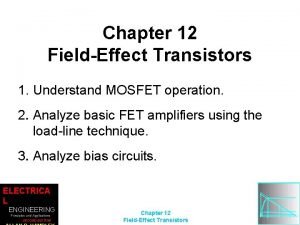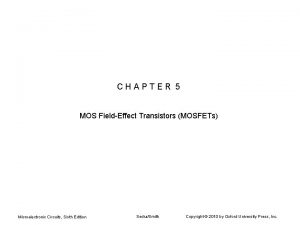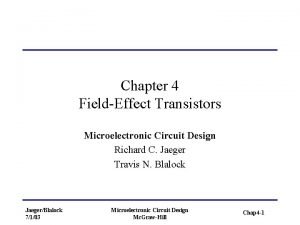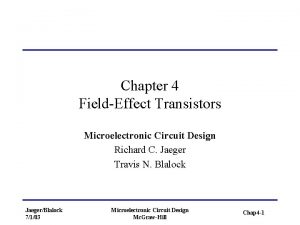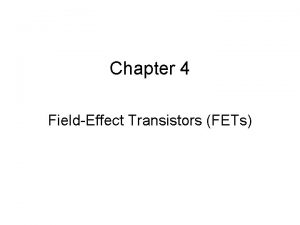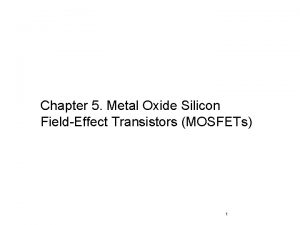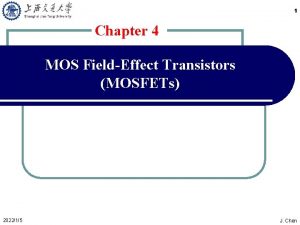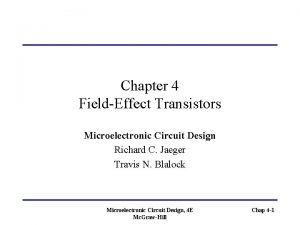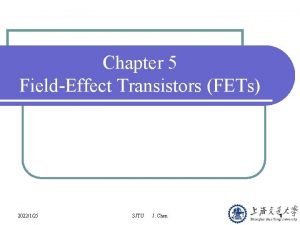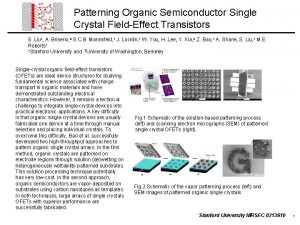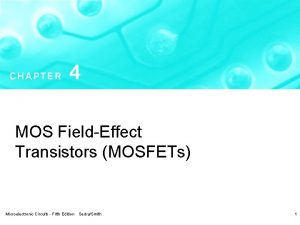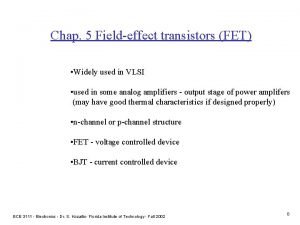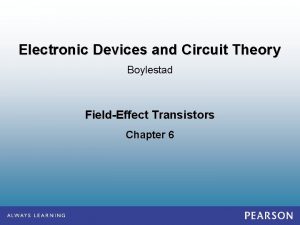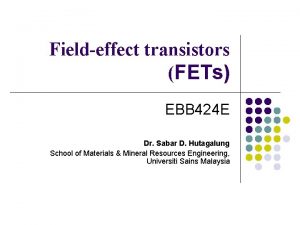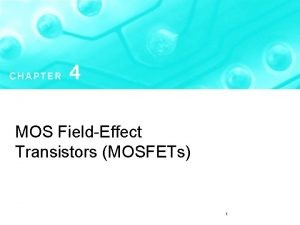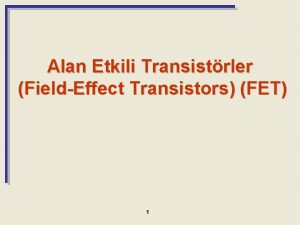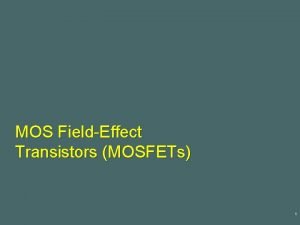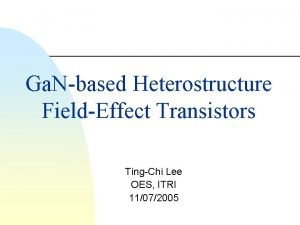FieldEffect Transistors Chapter 20 Introduction An Overview of
































- Slides: 32

Field-Effect Transistors Chapter 20 § Introduction § An Overview of Field-Effect Transistors § Insulated-Gate Field-Effect Transistors § Junction-Gate Field-Effect Transistors § FET Characteristics § Summary of FET Characteristics § FET Amplifiers § Other FET Applications Storey: Electrical & Electronic Systems © Pearson Education Limited 2004 OHT 20. 1

Introduction 20. 1 § Field-effect transistors (FETs) are probably the simplest form of transistor – widely used in both analogue and digital applications – they are characterised by a very high input resistance and small physical size, and they can be used to form circuits with a low power consumption – they are widely used in very large-scale integration – two basic forms: § insulated gate FETs § junction gate FETs Storey: Electrical & Electronic Systems © Pearson Education Limited 2004 OHT 20. 2

An Overview of Field-Effect Transistors 20. 2 § Many forms, but basic operation is the same – a voltage on a control input produces an electric field that affects the current between two other terminals – when considering amplifiers we looked at a circuit using a ‘control device’ – a FET is a suitable control device Storey: Electrical & Electronic Systems © Pearson Education Limited 2004 OHT 20. 3

§ Notation – FETs are 3 terminal devices § drain (d) § source (s) § gate(g) – the gate is the control input – diagram illustrates the notation used for labelling voltages and currents Storey: Electrical & Electronic Systems © Pearson Education Limited 2004 OHT 20. 4

Insulated-Gate Field-Effect Transistors 20. 3 § Such devices are sometimes called IGFETs (insulated-gate field-effect transistors) or sometimes MOSFETs (metal oxide semiconductor field-effect transistors) § Digital circuits constructed using these devices are usually described as using MOS technology § Here we will describe them as MOSFETs Storey: Electrical & Electronic Systems © Pearson Education Limited 2004 OHT 20. 5

§ Construction – two polarities: n-channel and p-channel Storey: Electrical & Electronic Systems © Pearson Education Limited 2004 OHT 20. 6

§ Operation – gate volt controls the thickness of the channel – consider an n-channel device § making the gate more positive attracts electrons to the gate and makes the gate region thicker – reducing the resistance of the channel. The channel is said to be enhanced § making the gate more negative repels electrons from the gate and makes the gate region thinner – increasing the resistance of the channel. The channel is said to be depleted Storey: Electrical & Electronic Systems © Pearson Education Limited 2004 OHT 20. 7

– the effect of varying the gate voltage Storey: Electrical & Electronic Systems © Pearson Education Limited 2004 OHT 20. 8

– gates as described above are termed Depletion. Enhancement MOSFETs or simply DE MOSFETs – some MOSFETs are constructed so that in the absence of any gate voltage there is no channel § such devices can be operated in an enhancement mode, but not in a depletion mode (since there is no channel to deplete) § these are called Enhancement MOSFETs – both forms of MOSFET are available as either n-channel or p-channel devices Storey: Electrical & Electronic Systems © Pearson Education Limited 2004 OHT 20. 9

§ MOSFET circuit symbols Storey: Electrical & Electronic Systems © Pearson Education Limited 2004 OHT 20. 10

Junction-Gate Field-Effect Transistors 20. 4 § Sometimes known as a JUGFET § Here we will use another common name – the JFET § Here the insulated gate of a MOSFET is replaced with a reverse-biased pn junction § Since the gate junction is always reverse-biased no current flows into the gate and it acts as if it were insulated Storey: Electrical & Electronic Systems © Pearson Education Limited 2004 OHT 20. 11

§ Construction – two polarities: n-channel and p-channel Storey: Electrical & Electronic Systems © Pearson Education Limited 2004 OHT 20. 12

§ Operation – the reverse-biased gate junction produced a depletion layer in the region of the channel – the gate volt controls the thickness of the depletion layer and hence thickness of the channel – consider an n-channel device § the gate will always be negative with respect to the source to keep the junction between the gate and the channel reversebiased § making the gate more negative increases the thickness of the depletion layer, reducing the width of the channel – increasing the resistance of the channel. Storey: Electrical & Electronic Systems © Pearson Education Limited 2004 OHT 20. 13

– the effect of varying the gate voltage Storey: Electrical & Electronic Systems © Pearson Education Limited 2004 OHT 20. 14

§ JFET circuit symbols Storey: Electrical & Electronic Systems © Pearson Education Limited 2004 OHT 20. 15

FET Characteristics 20. 5 § While MOSFETs and JFETs operate in different ways, their characteristics are quite similar § Input characteristics – in both MOSFETs and JFETs the gate is effectively insulated from the remainder of the device § Output characteristics – consider n-channel devices – usually the drain is more positive than the source – the drain voltage affects the thickness of the channel Storey: Electrical & Electronic Systems © Pearson Education Limited 2004 OHT 20. 16

Storey: Electrical & Electronic Systems © Pearson Education Limited 2004 OHT 20. 17

§ FET output characteristics Storey: Electrical & Electronic Systems © Pearson Education Limited 2004 OHT 20. 18

§ Transfer characteristics – similar shape for all forms of FET – but with a different offset – not a linear response, but over a small region might be considered to approximate a linear response Storey: Electrical & Electronic Systems © Pearson Education Limited 2004 OHT 20. 19

§ Normal operating ranges for FETs Storey: Electrical & Electronic Systems © Pearson Education Limited 2004 OHT 20. 20

§ When operating about its operating point we can describe the transfer characteristic by the change in output that is caused by a certain change in the input – this corresponds to the slope of the earlier curves – this quantity has units of current/voltage, which is the reciprocal of resistance (this is conductance) – since this quantity described the transfer characteristics it is called the transconductance, gm Note: Storey: Electrical & Electronic Systems © Pearson Education Limited 2004 OHT 20. 21

§ Small-signal equivalent circuit of a FET – models the behaviour of the device for small variations of the input about the operating point Storey: Electrical & Electronic Systems © Pearson Education Limited 2004 OHT 20. 22

Summary of FET Characteristics 20. 6 § FETS have three terminals: drain, source and gate § The gate is the control input § Two polarities of device: n-channel and p-channel § Two main forms of FET: MOSFET and JFET § In each case the drain current is controlled by the voltage applied to the gate with respect to the source § Behaviour is characterised by the transconductance § The operating point differs between devices Storey: Electrical & Electronic Systems © Pearson Education Limited 2004 OHT 20. 23

§ FET circuit symbols: Storey: Electrical & Electronic Systems © Pearson Education Limited 2004 OHT 20. 24

FET Amplifiers 20. 7 § A simple DE MOSFET amplifier – RG is used to ‘bias’ the gate at its correct operating point (which for a DE MOSFET is 0 V) – C is a coupling capacitor and is used to couple the AC signal while preventing externals circuits from affecting the bias – this is an AC-coupled amplifier Storey: Electrical & Electronic Systems © Pearson Education Limited 2004 OHT 20. 25

§ AC-coupled amplifier – input resistance – equal to RG – output resistance – approximately equal to RD – gain – approximately –gm. RD (the minus sign shows that this is an inverting amplifier) – C produced a low-frequency cut-off at a frequency fc given by where R is the input resistance of the amplifier (which in this case is equal to RG) Storey: Electrical & Electronic Systems © Pearson Education Limited 2004 OHT 20. 26

§ Negative feedback amplifier – reduces problems of variability of active components – voltage across Rs is proportional to drain current, which is directly proportional to the output voltage – this voltage is subtracted from input voltage to gate – hence negative feedback Storey: Electrical & Electronic Systems © Pearson Education Limited 2004 OHT 20. 27

§ Source follower – similar to earlier circuit, but output is now taken from the source – feedback causes the source to follow the input voltage – produces a unity-gain amplifier – also called a source follower Storey: Electrical & Electronic Systems © Pearson Education Limited 2004 OHT 20. 28

Other FET Applications 20. 8 § A voltage controlled attenuator – for small drain-to-source voltages FETs resemble voltage-controlled resistors – the gate voltage VG is used to control this resistance and hence the gain of the potential divider – used, for example, in automatic gain control in radio receivers Storey: Electrical & Electronic Systems © Pearson Education Limited 2004 OHT 20. 29

§ A FET as an analogue switch Storey: Electrical & Electronic Systems © Pearson Education Limited 2004 OHT 20. 30

§ A FET as a logical switch Storey: Electrical & Electronic Systems © Pearson Education Limited 2004 OHT 20. 31

Key Points § § § FETs are widely used in both analogue and digital circuits They have high input resistance and small physical size There are two basic forms of FET: MOSFETs and JFETs MOSFETs may be divided into DE and Enhancement types In each case the gate voltage controls the current from the drain to the source § The characteristics of the various forms of FET are similar except that they require different bias voltages § The use of coupling capacitors prevents the amplification of DC and produced AC amplifiers § FETs can be used to produce various forms of amplifier and a range of other circuit applications Storey: Electrical & Electronic Systems © Pearson Education Limited 2004 OHT 20. 32
 How pnp transistor works as a switch
How pnp transistor works as a switch Ujt equivalent circuit
Ujt equivalent circuit Application du transistor
Application du transistor Logic gates with truth table
Logic gates with truth table Cascode cascade
Cascode cascade 1 billion transistors
1 billion transistors Graphical analysis
Graphical analysis Physical structure of transistor
Physical structure of transistor Kilo mega giga tera peta
Kilo mega giga tera peta Transistors were used in which generation of computers
Transistors were used in which generation of computers Interpretations of moore's law assert that:
Interpretations of moore's law assert that: What is bioinformatics an introduction and overview
What is bioinformatics an introduction and overview Introduction product overview
Introduction product overview Introduction product overview
Introduction product overview Introduction product overview
Introduction product overview Introduction product overview
Introduction product overview Emt chapter 24 trauma overview
Emt chapter 24 trauma overview Chapter 14 medical overview
Chapter 14 medical overview Chapter 9 lesson 2 photosynthesis an overview
Chapter 9 lesson 2 photosynthesis an overview Chapter 12 selling overview
Chapter 12 selling overview Chapter 2 an overview of the financial system
Chapter 2 an overview of the financial system Chapter 1 overview of verb tenses
Chapter 1 overview of verb tenses Overview of personal finance chapter 1
Overview of personal finance chapter 1 Mesioclusion
Mesioclusion Chapter 1 introduction to personal finance
Chapter 1 introduction to personal finance Chapter 32 an overview of animal diversity
Chapter 32 an overview of animal diversity Chapter 1 an overview of financial management
Chapter 1 an overview of financial management Chapter 17 overview elements and their properties
Chapter 17 overview elements and their properties Chapter 1 overview of financial statement analysis
Chapter 1 overview of financial statement analysis Introduction paragraph structure
Introduction paragraph structure Www stands for world wide web
Www stands for world wide web Maximo work order priority
Maximo work order priority Universal modelling language
Universal modelling language
